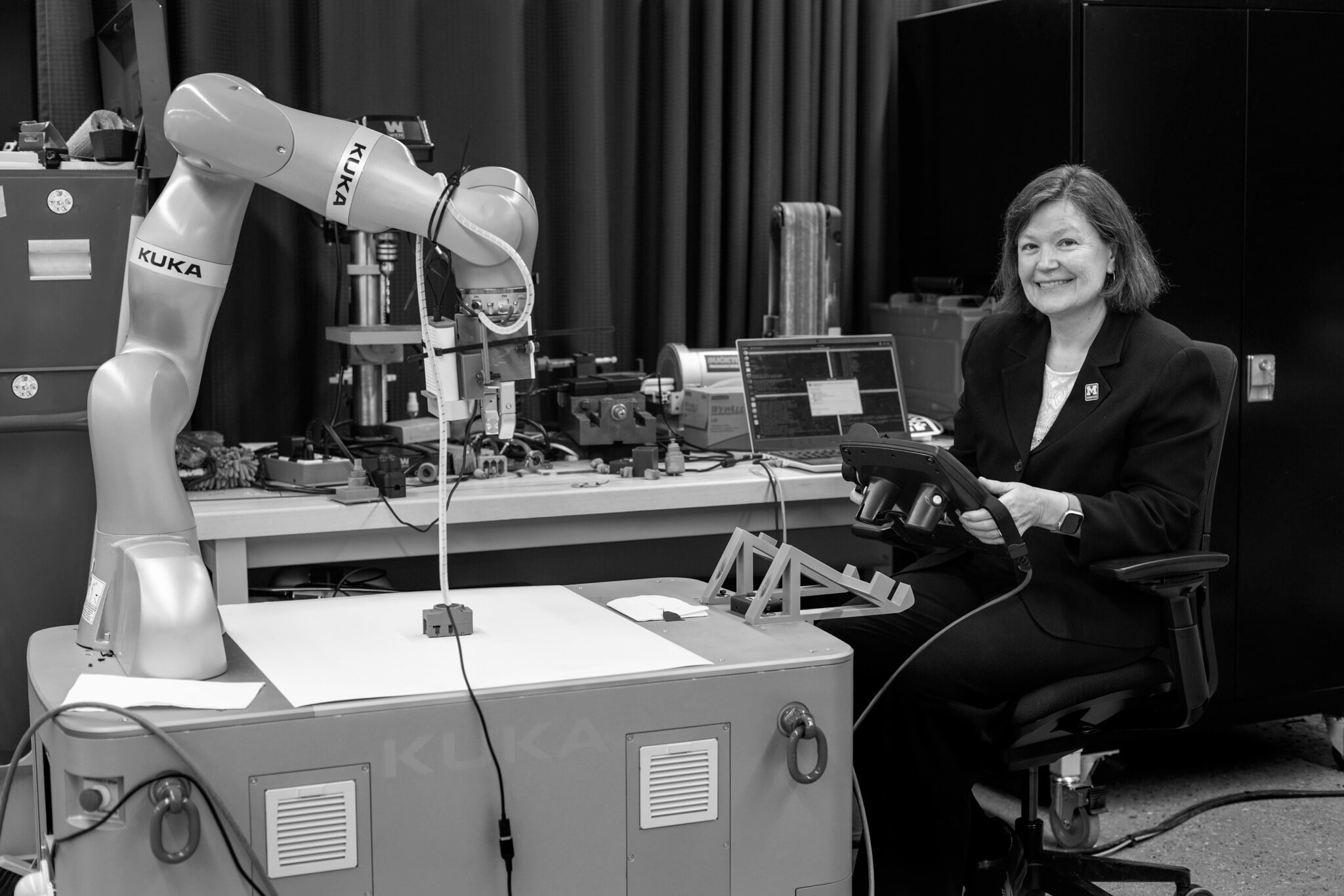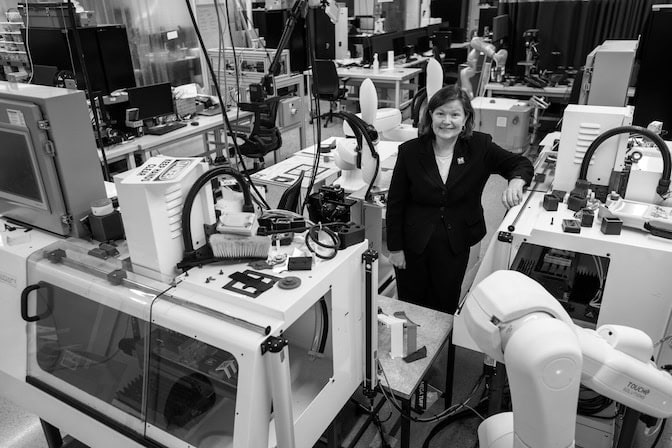
Leadership in networked and logic control systems
NAE profile: Dawn Tilbury, robotics

NAE profile: Dawn Tilbury, robotics
Get to know Michigan Engineering’s National Academy of Engineering members.
For advances in manufacturing network control and human-robot interaction and for engineering leadership, Tilbury was elected to the National Academy of Engineering in 2024. View the NAE citation.
More on Dawn Tilbury

Tilbury: So I grew up in a suburb of Minneapolis. You know, a pretty standard suburban household. My dad worked at Honeywell as an engineer. When I was applying to college, my father told me I should apply to engineering and if I liked it, I could stay. And if I didn’t like it, I could always switch into something else.
When I was graduating with my undergraduate degree, it was a really hot market for jobs. And every place I went for an interview, they’re like, well, what do you want to do? What do you want to do? Hardware. Do you want to do software? I had no idea what I wanted to do. So I decided I would go to graduate school and I could figure it out. I applied to a few different places and I ended up going to Berkeley for graduate school. And I really enjoyed the academic research, and teaching.
Tilbury: I got into manufacturing because my PhD research was really more on robotics and motion planning. Over the years, I’ve had opportunities to do different things. I like keeping my options open and looking at new things that would be interesting. While I was still an assistant professor, someone introduced me to a colleague from IBM who was trying to work on how do you control computing systems like database servers and web servers.
He was visiting the university, giving a talk in the computer science department. One of my friends in computer science said he should talk to me. So I had coffee with him, and I wrote a proposal to IBM and got some funding to do this kind of work. Then we got a, some funding from the National Science Foundation.
I spent part of my first sabbatical at IBM, working on control of computing systems, which was something I never would have thought about, and we ended up writing a book, which was interesting because I wrote the book at a sort of a junior undergraduate level.
Tilbury: Learn as much as you can, not only in classrooms, but through other student orgs or student teams. Learn to work with other people and learn to communicate, because that’s the most important thing. We’re seeing that ChatGPT is going to be able to solve homework problems, but they’re not creating the homework problems, or creating the new problems, or figuring out what problems need to be solved. In order to figure that out, you need to be able to talk to people. So I think communication skills are going to be critical and problem solving skills are still important because you need to figure out what problems are important to be solved and what tools you can use to solve which problems.
Tilbury: Something I always struggle with is trying to prioritize, because in a faculty career, there are so many amazing things you could be doing, and they all sound like a lot of fun and really great opportunities. They make an impact. And you only have 24 hours in a day and seven days in a week. So that is always a challenge for me.
I mean, it’s probably a challenge for everyone, right? But I think with a faculty job, I could collaborate with this person, I could write that proposal, I could advise this student, I could serve on that committee, I could write that review, I could write that paper. I mean, there’s just so many things to do. So that’s always a challenge for me.
Being a professor is like being a kid in a candy store. It all looks great. I always try to remind myself, yes, you can do it all, but not all at the same time. That’s hard because you want to do it all right away because it’s all fun. It’s a great job. I mean, it’s not all wine and roses. There are some challenging things, but I think the big challenge is trying to figure out what I should be doing at each time. I will say I’m not always the best at it, but I do things that I think I enjoy.
Tilbury: I believe that right now we have a pretty good culture in the robotics department. It’s not perfect, but I think what I hear from the students and from the faculty is that we’ve made an effort to create an environment here that’s very welcoming, very respectful, and allows everyone to have a chance to learn something about robotics and make a difference in that field.
I hope that we can keep this environment as we grow, because we will grow pretty quickly. That’s going to be a challenge because once things get too big, simple solutions are easier to implement. This culture of support and collaboration takes more communication, takes more time, takes more energy. I hope we can continue that culture as we grow.
We are also absolutely hitting the limits of this building. So that’s going to create stress. When there’s plenty of resources, people are less stressed. But as resources become constrained, we need to be more creative in figuring out how to deal with that and not have people fighting with each other, but collaborating to make the best use of what we have.
I hope as a department chair, I can help facilitate that culture, make sure that people understand the resources that we have, how we’re using them, and how we can build that culture. That’s what I’d like to be able to leave as my legacy in the robotics department.
Quotes edited from interview transcript between Dawn Tilbury and Marcin Szczepanski.